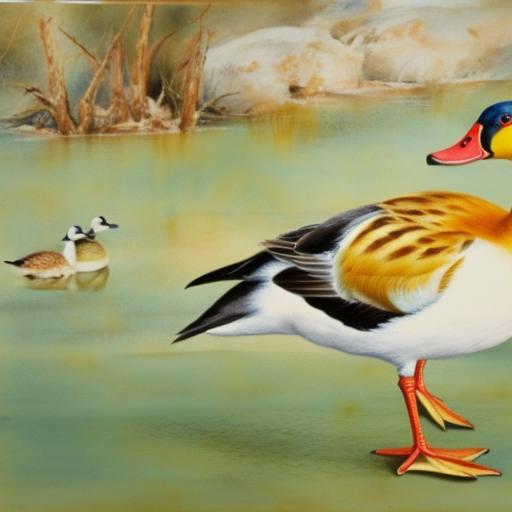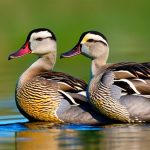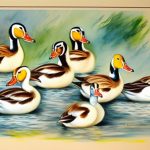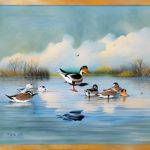Ducks are a diverse group of waterfowl that come in a wide variety of breeds, each with its own unique characteristics and traits. Some of the most popular duck breeds include the Pekin, Mallard, Rouen, and Muscovy. Each breed has its own distinct appearance, size, and coloration, making them popular choices for both backyard hobbyists and commercial farmers. Pekin ducks, for example, are known for their large size and white feathers, while Mallards are smaller and have the classic green head and brown body. Understanding the different duck breeds is important for anyone interested in raising ducks, as it can help them choose the right breed for their specific needs and goals.
Duck breeds also vary in terms of their egg-laying capabilities, meat production, and overall hardiness. For example, the Khaki Campbell is a popular breed known for its high egg production, making it a favorite among those looking to raise ducks for their eggs. On the other hand, the Muscovy duck is prized for its lean and flavorful meat, making it a popular choice for those interested in raising ducks for meat production. Additionally, some duck breeds are better suited for certain climates or environments, so it’s important to consider these factors when choosing a breed. Overall, understanding the different duck breeds and their unique characteristics is essential for anyone looking to raise ducks, whether for eggs, meat, or simply as pets.
Key Takeaways
- There are many different duck breeds, each with unique characteristics and traits.
- Duck mating behavior is influenced by factors such as age, environment, and social dynamics within a flock.
- Factors affecting duck mating include availability of food and water, nesting sites, and predator presence.
- Interbreeding between duck breeds can result in hybrid offspring with a combination of traits from both parent breeds.
- Challenges of interbreeding ducks include genetic incompatibility, health issues, and difficulty in maintaining breed standards.
- Successful crossbreeding examples include the creation of new breeds with desirable traits and improved productivity.
- It is important to carefully consider the implications of interbreeding and to seek guidance from experts when attempting to crossbreed ducks.
Understanding Duck Mating Behavior
Duck mating behavior is a fascinating aspect of duck biology that plays a crucial role in the reproduction and survival of the species. Unlike many other birds, ducks are known for their complex mating rituals and behaviors, which can vary significantly between different breeds. One common mating behavior among ducks is the courtship display, where males will often perform elaborate dances or vocalizations to attract females. This behavior is particularly prominent in species like the Mallard, where males will display their colorful plumage and perform intricate displays to impress potential mates.
Another important aspect of duck mating behavior is pair bonding, where males and females form monogamous pairs during the breeding season. This behavior is particularly common in species like the Mandarin duck, where pairs will often stay together for the entire breeding season and sometimes even longer. Understanding these mating behaviors is important for anyone looking to breed ducks, as it can help them create suitable environments and conditions for successful mating and reproduction. Additionally, understanding duck mating behavior can also provide valuable insights into the social dynamics and reproductive strategies of these fascinating birds.
Factors Affecting Duck Mating
Several factors can affect duck mating behavior and success, including environmental conditions, social dynamics, and genetic factors. Environmental conditions such as habitat quality, food availability, and nesting sites can all influence duck mating behavior and success. For example, ducks require suitable nesting sites with access to water and food resources to successfully raise their offspring. Additionally, factors such as temperature and weather patterns can also impact duck mating behavior, as extreme conditions can affect breeding success and chick survival.
Social dynamics within duck populations can also play a significant role in mating behavior. Dominance hierarchies and competition for mates can influence which individuals are successful in finding a mate and reproducing. In some cases, dominant males may have greater access to females and be more successful in mating, while subordinate individuals may struggle to find mates. Understanding these social dynamics is important for anyone looking to breed ducks, as it can help them create suitable environments and conditions for successful mating and reproduction.
Genetic factors can also play a role in duck mating behavior and success. Inbreeding depression, for example, can occur when closely related individuals mate, leading to reduced fertility and offspring viability. Breeders must carefully manage genetic diversity within their duck populations to avoid these issues and maintain healthy breeding stock. Overall, understanding the various factors that can affect duck mating behavior is essential for anyone looking to successfully breed ducks.
Interbreeding Between Duck Breeds
Interbreeding between different duck breeds is a common practice among breeders looking to create new and unique varieties with specific traits or characteristics. This process involves mating individuals from different breeds to produce hybrid offspring with a combination of traits from each parent breed. Interbreeding can be used to introduce new genetic diversity into a population, improve certain traits such as egg production or meat quality, or create new color patterns or plumage variations.
One common example of interbreeding is crossing the Pekin duck with the Mallard to create the popular hybrid known as the Moulard. This hybrid is prized for its fast growth rate and high-quality meat production, making it a popular choice among commercial duck farmers. Another example is crossing the Khaki Campbell with the Indian Runner to create a hybrid known as the Golden 300, which is known for its high egg production and excellent foraging abilities. These examples demonstrate how interbreeding can be used to create new and improved varieties with specific traits that are desirable for different purposes.
While interbreeding can be a useful tool for creating new varieties with desirable traits, it’s important to carefully manage these practices to avoid negative consequences such as inbreeding depression or loss of genetic diversity. Breeders must also consider the welfare of the animals involved and ensure that any hybrid offspring are healthy and viable. Overall, interbreeding between duck breeds can be a valuable tool for creating new varieties with specific traits or characteristics.
Challenges of Interbreeding Ducks
While interbreeding between duck breeds can be a useful tool for creating new varieties with specific traits or characteristics, it also presents several challenges that breeders must carefully manage. One common challenge is maintaining genetic diversity within the population to avoid issues such as inbreeding depression or loss of valuable traits. Intensive interbreeding practices can lead to reduced genetic diversity within a population, which can have negative consequences for the health and viability of the animals involved.
Another challenge of interbreeding ducks is managing the welfare of the animals involved. Some hybrid offspring may inherit undesirable traits or health issues from their parent breeds, leading to welfare concerns for the animals. Breeders must carefully consider the potential consequences of interbreeding on the health and well-being of the animals involved and take steps to ensure that any hybrid offspring are healthy and viable.
Additionally, interbreeding can also lead to challenges in maintaining breed standards and preserving the unique characteristics of individual breeds. Intensive interbreeding practices can lead to a loss of distinct traits or color patterns that are characteristic of specific breeds, leading to a loss of genetic diversity within the population. Breeders must carefully manage interbreeding practices to preserve the unique characteristics of individual breeds while still creating new varieties with desirable traits.
Overall, while interbreeding between duck breeds can be a valuable tool for creating new varieties with specific traits or characteristics, it presents several challenges that breeders must carefully manage to ensure the health and welfare of the animals involved.
Successful Crossbreeding Examples

Despite the challenges associated with interbreeding ducks, there have been several successful examples of crossbreeding that have led to the creation of new and improved varieties with specific traits or characteristics. One successful example is the crossbreeding of the Pekin duck with the Mallard to create the Moulard hybrid. This hybrid is prized for its fast growth rate and high-quality meat production, making it a popular choice among commercial duck farmers. The Moulard hybrid demonstrates how crossbreeding can be used to create new varieties with specific traits that are desirable for different purposes.
Another successful example is the crossbreeding of the Khaki Campbell with the Indian Runner to create the Golden 300 hybrid. This hybrid is known for its high egg production and excellent foraging abilities, making it a popular choice among those looking to raise ducks for their eggs. The Golden 300 hybrid demonstrates how crossbreeding can be used to create new varieties with specific traits that are desirable for different purposes.
These successful examples of crossbreeding demonstrate how this practice can be used to create new and improved varieties with specific traits or characteristics that are desirable for different purposes. While there are challenges associated with interbreeding ducks, these examples show that with careful management and consideration of genetic diversity and animal welfare, crossbreeding can be a valuable tool for creating new varieties with specific traits or characteristics.
Conclusion and Recommendations
In conclusion, understanding duck breeds and their unique characteristics is essential for anyone looking to raise ducks for eggs, meat, or simply as pets. Duck mating behavior is a fascinating aspect of duck biology that plays a crucial role in the reproduction and survival of the species. Factors such as environmental conditions, social dynamics, and genetic factors can all affect duck mating behavior and success.
Interbreeding between different duck breeds can be a useful tool for creating new varieties with specific traits or characteristics but presents several challenges that breeders must carefully manage. Maintaining genetic diversity within the population, managing animal welfare concerns, and preserving breed standards are all important considerations when interbreeding ducks.
Despite these challenges, there have been successful examples of crossbreeding that have led to the creation of new and improved varieties with specific traits or characteristics. With careful management and consideration of genetic diversity and animal welfare, crossbreeding can be a valuable tool for creating new varieties with specific traits or characteristics.
In light of these findings, it is recommended that breeders carefully consider the potential consequences of interbreeding on genetic diversity and animal welfare when engaging in crossbreeding practices. Additionally, efforts should be made to preserve the unique characteristics of individual breeds while still creating new varieties with desirable traits through crossbreeding practices. By carefully managing these practices, breeders can create new and improved varieties of ducks with specific traits or characteristics that are desirable for different purposes while ensuring the health and welfare of the animals involved.
If you’re interested in learning about how different breeds of ducks mate, you might also want to check out this informative article on turning a shed into a chicken coop at PoultryWizard. Understanding the mating behaviors of ducks can be crucial for successful breeding and raising of these beautiful birds.
FAQs
Will different breeds of ducks mate?
Yes, different breeds of ducks can mate with each other. Ducks are known to be quite promiscuous and will often mate with ducks of different breeds.
What are the potential outcomes of mating different breeds of ducks?
When different breeds of ducks mate, the offspring will typically exhibit a mix of traits from both parent breeds. This can result in a wide variety of colors, patterns, and physical characteristics in the offspring.
Are there any potential issues with mating different breeds of ducks?
In some cases, mating different breeds of ducks can lead to genetic issues or health problems in the offspring. It’s important to carefully consider the genetics of the parent ducks before allowing them to mate.
Can different species of ducks mate with each other?
In some cases, different species of ducks can mate with each other, but this is less common than mating between different breeds within the same species. When different species of ducks do mate, the offspring are known as hybrids.
Do ducks form long-term mating pairs?
Some species of ducks do form long-term mating pairs, while others are more promiscuous and will mate with multiple partners. It varies depending on the species and individual behavior of the ducks.
Meet Walter, the feathered-friend fanatic of Florida! Nestled in the sunshine state, Walter struts through life with his feathered companions, clucking his way to happiness. With a coop that’s fancier than a five-star hotel, he’s the Don Juan of the chicken world. When he’s not teaching his hens to do the cha-cha, you’ll find him in a heated debate with his prized rooster, Sir Clucks-a-Lot. Walter’s poultry passion is no yolk; he’s the sunny-side-up guy you never knew you needed in your flock of friends!







